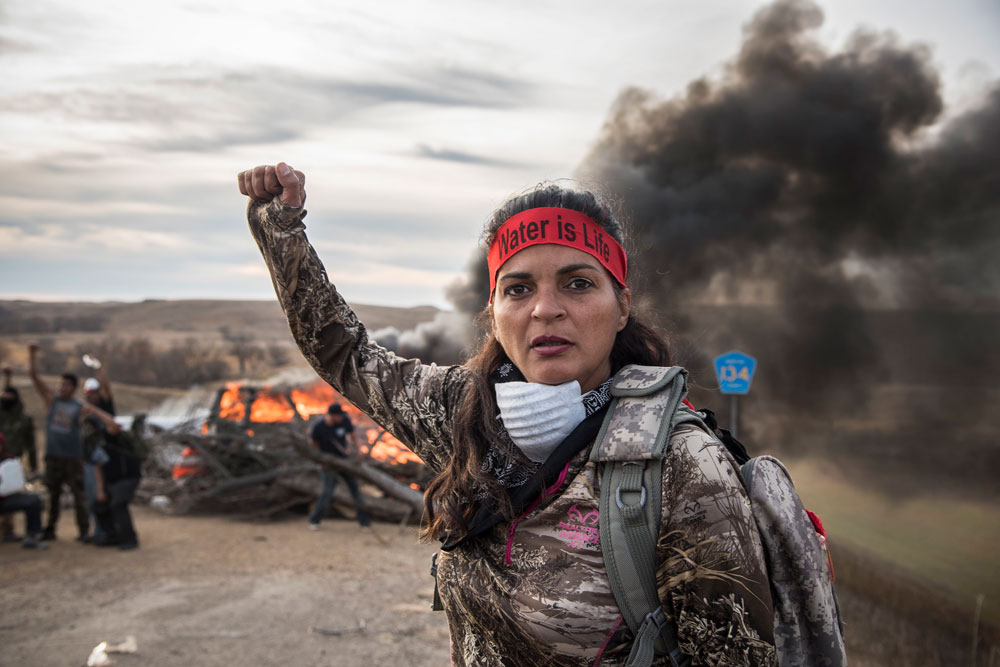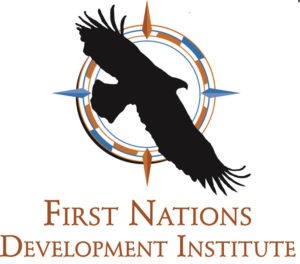
Over the next two months, NPQ, in partnership with the First Nations Development Institute (First Nations), will publish on a weekly basis a series of articles that lift up Native American voices to highlight issues concerning environmental justice in Indian Country and identify ways that philanthropy might more effectively support this work.

Greetings. I am excited to kick off a new article series focused on Native communities and environmental justice. This series builds on the one NPQ and First Nations co-developed last fall and will highlight voices of respected Native American nonprofit leaders who are on the frontlines addressing so many of the fundamental environmental challenges of our time.
Too often, Native voices in all aspects of American life are silenced and marginalized. But here Native community leaders will speak directly for themselves about their important work to positively transform Native communities and build sustainable futures.
Throughout the United States, Native communities are actively working to combat environmental racism and climate change. These Native leaders are working to elevate indigenous knowledge and practices as it relates to Native lands and natural resources.
Here’s a little context about some of the critical environmental justice and climate change-related work under way in Native communities.
1. Environmental justice is not a new idea in Native communities.
It is important to acknowledge that Native communities have long had a different relationship with the environment compared to individuals from Western society. Although there are differences among Native communities, the worldview of Native people generally sees the land and environment as intrinsically intertwined with human development and wellbeing. Native people have long acknowledged that decisions we make today have lasting effects on future generations. Thus, we have a responsibly to act as accountable stewards of the land and environment for future generations. Some nations have termed this as planning for “seven generations.” As David Wilkins, Lumbee, writes in Indian Country Today, this means that each generation is responsible “to teach, learn, and protect the three generations that had come before it, its own, and the next three. In this way, we maintained our communities for millennia.”
But it important to not romanticize Native relationships to land and the environment. Wilkins warns us to avoid the “destructive myth of mystical, all-seeing Natives. In truth, our peoples were visionary but not in a passive, new-age way. We actively tended our families and our clan-ties by holding the lives, memories, and hopes of all Seven Generations close.”
In contrast, when white-dominated nations emerged on what is today called the North American continent, they believed it was their Manifest Destiny to conquer the land and all of its inhabitants from sea to shining sea. Euro-Americans believed that humans were atop the earth’s hierarchy (by divine placement). Thus, precious land and resources should be exploited for the benefit of human development and progress. In this worldview, there is no acknowledgement, accountability, or responsibility for future generations.
In sum, Native people have long held a worldview that connects human and community health to the health of land and the environment. It shapes and perpetuates Native identities, cultures, and worldviews. And, today, as concepts such as stewardship become more important to the sustainability of our entire planet, there is added value in listening to Native voices, who were environmentalists before environmentalism became popular.
2. Native communities have long been on the frontlines fighting against environmental racism and promoting environmental justice.
Climate change-related events and environmental degradation have increasingly gripped headlines as citizens feel the brunt of these manmade crises. But one message rarely makes headlines: study after study documents that people of color and low-income communities have been and will continue to be hit the hardest by environmental degradation and climate change.
In fact, new research has suggested that climate change factors like air pollution are disproportionately caused by consumption of goods and services by white Americans yet are disproportionately inhaled or experienced by people of color. Thus, conversations about climate change cannot be separated from environmental justice and active efforts by communities of color to combat environmental racism.
Indigenous peoples have long been at the forefront of fighting for environmental justice. In 2016, Water Protectors generated national headlines as they mobilized to protect land and water on the Standing Rock Reservation in North Dakota fighting against the Dakota Access Pipeline. More recently, Native Hawaiian communities have mobilized to protect their sacred Maunakea from desecration. Although these recent events have forced Indigenous movements for environmental justice into mainstream consciousness, these movements exist on a long continuum of Indigenous resistance to the disruptions of Native existence strongly connected to land and natural landscapes.
Indigenous peoples across the US have long organized to protest the hazardous waste contaminating their lands by nuclear test sites, uranium, coal, gas and oil development, and toxic waste dumping. These extractive energy practices, largely benefiting non-Native populations, have been linked to high rates of cancer, kidney problems, lung disease, asthma, and heart and vision problems of Native people, all associated with land, water, and air pollution.
Native women are further impacted by this type of environmental racism, as Native women and children have high rates of contaminants in their blood streams and are impacted by birth defects, miscarriages, and reproductive organ cancers. More recently, Native women have been the target of violent exploitation and sexualization (especially by Non-Native men) near natural resource extraction sites.
Sign up for our free newsletters
Subscribe to NPQ's newsletters to have our top stories delivered directly to your inbox.
By signing up, you agree to our privacy policy and terms of use, and to receive messages from NPQ and our partners.
In sum, environmental racism is not color-blind and has a direct impact on Native communities (as well as other communities of color). Native women and their children are even more impacted by environmental racism in Native communities.
3. Economic context is important to understand environmental justice in Native communities.
Extreme levels of poverty in Native communities make decisions around natural resource protection and extraction difficult for the leaders of Native nations. Some economists have suggested that “Native communities are islands of poverty in a sea of wealth.” This is because there are over 570 federally recognized Native nations in the US and they commutatively occupy over 56 million acres of land and 57 million acres of subsurface mineral estates.
Native lands, once thought to be barren and desolate spaces only fit for American Indians, are estimated to house nearly 30 percent of the nation’s coal reserves west of the Mississippi, as much as 50 percent of potential uranium reserves, and up to 20 percent of known natural gas and oil reserves. In all, Native lands today house over 15 million acres of potential energy and mineral resources.
Economic development and other pro-energy organizations have advocated for reducing barriers for American Indian nations and people to lease these valuable resources to mostly non-Native companies for exploitation and development. Extreme poverty and economic underdevelopment in Native communities have indeed driven some Native nations to engage in resource extraction and other development strategies that contribute to climate change and other forms of environmental degradation for the purpose of economic development.
But a large amount of natural resources in Native communities still remain untapped. The vast amount of natural resources in Native communities offer abundant opportunities for philanthropy to partner with Native nations and people to create incentive structures and philanthropic models that are aligned with the values of environmental justice and promote more sustainable pathways for economic development in Native communities. In fact, some Native nations are already leading the way in terms of looking at sustainable energy alternatives that can be a catalyst for promoting green economies in Native communities.
4. There is a lack of philanthropic investment in Native-led change.
Despite the long history of Native resistance, philanthropy investment in these movements mirrors their overall marginal investments in Native communities. According to Candid and Native Americans in Philanthropy, since 1990, giving to Native communities and causes has not substantively increased over time. Today, only about 0.4 percent of large foundation grants go to supporting Native communities and causes, far less than the two percent of Native Americans in the US population. The percentage of philanthropic resources directly reaching Native communities on the frontlines of social change is even less.
For example, according to the Candid and Native Americans in Philanthropy Funding Map, about $4.2 million in grants was awarded by large foundations to support environmental justice and climate change causes from 2014–2018. Roughly 53 percent of these resources were awarded to non-Native controlled organizations, including large universities and other big-green organizations.
In First Nations’ work to support environmental justice, Native communities often express extreme frustration with non-Native-led organizations that receive grant dollars to do work in or for Native communities (not led or directed by Native communities). They often express frustration with the imposed Western approaches that do not center Native values, worldviews, or frameworks around land and resource stewardship. Most note that these non-Native-led groups swoop into Native communities when funding is available but quickly leave when the grants disappear.
This has led to “aid fatigue” among some Native communities, who now express extreme hesitation in partnering with non-Native groups. The lack of investment in Native-led change and dismissal of community-based knowledge in promoting environmental justice essentially entrenches models of philanthropic colonialism in Native communities.
5. Environmental and climate justice cannot happen without including Native voices.
The environmental justice movement in the US continues to have a problem with diversity. Environmentally focused nongovernmental organizations (NGOs) continue to be entrenched in whiteness, including the hiring and board composition of environmentally focused nonprofits. Moreover, funders who support the environmental movement in the US still remain overwhelmingly white.
Overall, while communities of color will be disproportionately impacted by environmental degradation and climate change, they are not in positions to make funding decisions about their individual and community well-being.
The composition of environmental nonprofits and the individuals within funding institutions has a direct impact on the voices that are heard (or not), and the approaches that are taken (or not) to advance environmental justice and combat climate change. For Native communities, this means that traditional ecological knowledge is often dismissed, trivialized, and minimized in environmental discussions.
Some people, like Mark Dowie, in his book Conservation Refugees, would argue that these large NGOs and the foundations that support them are fighting for conservation at the expense of Indigenous rights and sovereignty.
This status quo of the environmental and climate movements cannot persist. Without including Native voices, there cannot be a vibrant environmental and climate movement.
More to Come
These are some of the most pertinent challenges that face Native peoples and communities as they continue to fight for their place in the broader environmental and climate change movements. In the coming weeks, you will hear from brilliant Native people that are on the frontlines of building healthier and sustainable communities. We hope that these articles spark change in how philanthropy supports Native-led change and how green organizations interact with communities of color and especially Native communities.










